
January 24, 2022, by Franziska Koch
CfP – Journal of Contemp. Chin. Art calls for articles related with performance art in China (deadline: 31 March 22)
Journal of Contemporary Chinese Art calls for contributions discussing performance art in China
Performance art bases an artist’s practice on direct action. In China, performance art is known by the term xingwei yishu (lit. behaviour art). Other terms include action art (xingdong yishu), body art (shenti yishu) and live art (xianchang yishu). Each term links to a practice that involves the body, but can also arise in the use of the body in installation art, video art and even painting. Performance art has been linked to public actions by artists during the 1980s, culminating in the 1989 China Avant/Garde exhibition in Beijing, most notably by artist Xiao Lu, shooting a gun at her installation during the opening. Performance art first rose to prominence during the 1990s when artists across China started to engage in performances that position the body in direct contact with the physical environment. These include artists from the Beijing East Village, such as Cang Xin, Duan Yingmei, Ma Liuming, Zhang Binbin, Zhang Huan and Zhu Ming. During the 1990s performance art in China also becomes known through artists who test their body through endurance, such as in performances by He Yunchang and Li Binyuan. Or by the feminist artist Li Xinmo. The late 1990s and early 2000s also witness the rise of performance art festivals in China. Discourses on performance and performance art can also be linked to dance, experimental theatre and to new media, such as in the case of Lu Yang or Chen Tianzhuo. Discourses on performance art also include those on live art and documentation, performativity, and performance in relation to public and private conduct, with certain performances having been censored in China. This special issue also aims to elaborate papers tracing the development of performance art beyond Mainland China, with early performance artists such as Kwok Mang Ho (Frog King) in Hong Kong and Teching Hsieh in Taiwan, who would become a foundational performance artist in New York during the late 1970s and 1980s. Or, Wu Mali who, from the 1980s onwards, has been creating participatory works and socially engaged art in Taiwan, another important figure in the field of performance art, broadly conceived alongside other performance artists active across Greater China, from the 1980s and 1990s until now.
Possible perspectives for proposals include (but are not limited to) the following:
· Case studies of individual artists across Greater China and the Chinese diaspora.
· Discourses of performance art in places and contexts across Greater China.
· Discourses on performance art festivals across Greater China, and their role in disseminating public awareness of performance art (and live art).
· Changing perspectives and vocabularies on contemporary Chinese performance art, action art, body art and live art.
· The role of the body in relation to performance art in China.
· The position of performance and performativity in Chinese art and culture, especially regarding alternative discourses of performance art and related practices.
· Issues of public and private conduct in relation to contemporary Chinese art and performance art, including where discourses and practices have been censored.
Publication Timeline
31 March 2022, abstract due (300 words)
1 December 2022, full manuscript due (7,000-8,000 words)
Publication: Spring 2023
Please send abstract submissions and 100-word biography for consideration in the same file to: Guest Editor Thomas Berghuis, researcher based in Leiden, the Netherlands (dr.t.j.berghuis@gmail.com) and Assistant Editor Lauren Walden (ccva@bcu.ac.uk) with the subject ‘JCCA 10.1’. Please visit Intellect’s website www.intellectbooks.com for referencing guidelines.
No comments yet, fill out a comment to be the first

Leave a Reply